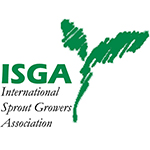April 11 is World Parkinson’s Day. It is named after Dr. James Parkinson, an early 19th century doctor, who first described the disease as manifesting itself as involuntary motions and decreased muscular power.
There is no cure for this disease, but there are medicines and surgery to control the symptoms of this neurodegenerative disease that affects nerve cells which control motor functions.
On this day and during the next few weeks there will be events to raise funds, advocate for research and increase awareness of this disease. In the spirit of this day, ISGA is presenting two studies about fava bean sprouts. Fava bean sprouts are a rich source of L-DOPA which is used in the treatment of Parkinson’s disease. The studies below describe experiments which seek to find ways to enhance the effectiveness of fava bean sprouts as a treatment for the symptoms of Parkinson’s disease.
Fava Bean Sprouts: Enhancing Functionality
Improved health-relevant functionality in dark germinated Mucuna pruriens (Fava Bean) sprouts by elicitation with peptide and phytochemical elicitors.
Bioresour Technol. 2009 Oct;100(19):4507-14. Epub 2009 May 19 Randhir R, Kwon YI, Shetty K. Department of Food Science, Chenoweth Laboratory, University of Massachusetts, Amherst, MA 01003, USA.
The health-relevant functionality of Mucuna pruriens (Fava Bean) was improved by priming the seeds with elicitors of the pentose phosphate pathway (PPP) such as fish protein hydrolysates (FPHs), lactoferrin (LF) and oregano extract (OE) followed by dark germination. FPH elicited the highest phenolic content of 19 mg/g FW on day 1, which was 38% higher than control sprouts. OE enhanced Parkinson’s disease-relevant L-DOPA content by 33% on day 1 compared to control sprouts. Anti-diabetes-relevant alpha-amylase inhibition percent (AIP) and alpha-glucosidase inhibition percent (GIP) were high in the cotyledons and decreased following elicitation and sprouting. For potential anti-diabetic applications, low AIP and high GIP with moderate L-DOPA content on day 4 of dark germination could be optimal. Improved L-DOPA concentrations in a soluble phenolic and antioxidant-rich M. pruriens background on day 1 sprouts have potential for Parkinson’s disease management.
Improving Phytopharmaceutical Value of Fava Bean Sprouts
L-DOPA and Total Phenolic Stimulation in Dark Germinated Fava Bean in Response to Peptide and Phytochemical Elicitors
Process Biochemistry Volume 37, Issue 11 , June 2002, Pages 1247-1256 Reena Randhir, Preethi Shetty and Kalidas Shetty Department of Food Science, Chenoweth Laboratory, University of Massachusetts, Amherst, MA 01003, USA
Fava bean sprouts are a rich source of levo dihydroxy phenylalanine (L-DOPA) the precursor of dopamine and is used in the treatment of Parkinson’s disease. Its phytopharmaceutical value was improved by priming the seeds with natural elicitors like fish protein hydrolysates (FPH), lactoferrin (LF) and oregano extract (OE). The elicitors in general stimulated the phenylpropanoid pathway through the pentose phosphate and shikimate pathway and enhanced the production of phenolics. Among the different FPH elicitor concentrations, 2 ml/l elicited the highest phenolic content of 3.4 mg/gFW on day 2, which is three times higher than that of control. LF proved to be a better elicitor at a low concentration of 50 ppm producing 5.2 mg of phenolics/gFW on day 3. The response of fava bean treated with 5 ml/l of OE showed the highest phenolic stimulation of 2.9 mg/gFW on day 3. Control, FPH and OE elicitors showed a higher antioxidant activity in germinating fava bean sprout on day 1 and 2 which correlated with higher phenolic content. In fava bean primed with FPH, the glucose-6-phosphate dehydrogenase (G6PDH) and guaiacol peroxidase (GPX) activity peaked on day 5 followed by a concurrent increase in phenolics on day 6 demonstrating the mobilization of carbohydrates from the cotyledons towards the phenylpropanoid pathway in response to the elicitors. In the case of both LF and OE the peak activity of G6PDH and GPX was seen just prior to the boost in phenolics on day 3 and drops to a minimal on day 4 suggesting that the products may allosterically regulate the enzyme. For all elicitors and control the L -DOPA content was high on day 1 and steadily declined with germination. The L-DOPA content in fava bean elicited by LF showed a 40% increase, where as FPH and OE showed a 20% increase compared to that of the control. The maximal stimulation of L-DOPA content was seen on day 2 for fava bean treated with 2 ml/l of FPH, which was 100% higher than that of control.

